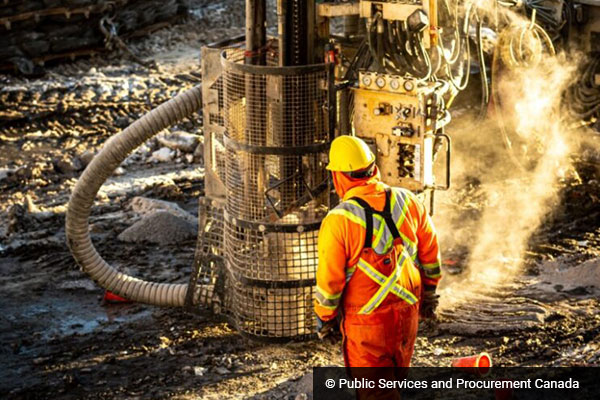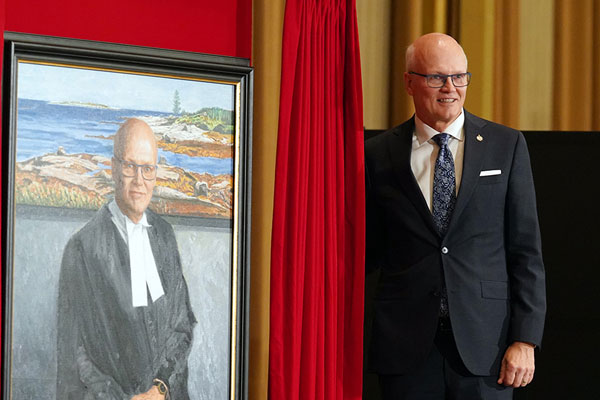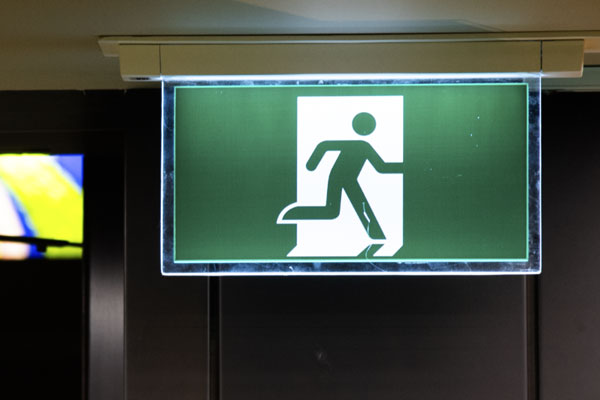Reporting on Results
This year, the House Administration developed a new strategic plan. The Board of Internal Economy, the governing body of the House of Commons, makes sure that progress against the strategic plan is shared in the annual Report to Canadians.
A new strategic plan for the House of Commons Administration
In April 2023, the House Administration released its Strategic Plan 2023–2026. This plan sets out the organization’s priorities and strategies for three years. It helps to guide decisions and to focus resources so that the House Administration can carry out its mandate.
Vision
One House, One Team
Mission
Together—where everyone has a voice—we innovate, anticipate, and respond to the needs of the House and its Members in support of parliamentary democracy.
Values
Integrity and impartiality, Service excellence, Collaboration, and Inclusion
Strategic priorities
The Strategic Plan 2023–2026 outlines three priorities that serve as a roadmap for the House Administration:
Our people
A professional, diverse, and healthy workforce where employees feel connected and well supported in their development and their career journey.
Our workplace
(Information, Technology, Facilities, Infrastructure and Equipment)
An adaptive, informed, connected, and secure workplace that enables our current and future work.
Our service delivery
A seamless experience that is client-centric, integrated, and accessible.
Highlights of 2023–2024 results
This section presents some of the work carried out by the House Administration between April 1, 2023 and March 31, 2024. This work supports Members’ activities and aligns with our three priorities:
Our people
Improving accessibility in recruitment practices
The House Administration reviewed its Recruitment and Selection Policy and added inclusion as a guiding principle. This policy puts emphasis on the importance of creating a barrier‑free workplace to recruit more persons with disabilities. Staffing advisors received training and tools on the inclusion of persons with disabilities and on making interview processes more accessible. The House Administration released a new, more accessible hiring portal and updated its job offer templates to include requests for accommodations.
Working together toward equity
The House Administration is committed to supporting the Pay Equity Act that came into effect on August 31, 2021. The Pay Equity Committee, set up in June 2022, was given the task of analyzing roles within the House Administration, finding gender pay gaps, and developing a pay equity plan. The goal is to ensure that House employees in jobs that are commonly held by women receive equal pay for work of equal value. Earlier this year, the House Administration started the Job Renewal initiative. This initiative further supports pay equity by grouping similar roles by job description. These descriptions have been updated, standardized, and made accessible.
The Women’s Leadership Network marked its one-year anniversary on International Women’s Day. As part of 16 Days of Activism Against Gender-based Violence, the Network organized a white ribbon campaign in December to raise awareness and to commemorate victims of gender-based violence.

What is the Pay Equity Act?
The Act is meant to get equal pay for employees in jobs typically held by women by tackling gender discrimination in the pay practices and systems of federal employers. Implementing the Pay Equity Act should help to close the gender pay gap. It should also help workers receive the same pay for work of the same value. It introduces long‑lasting changes so that women’s work is valued and rewarded fairly, now and in the future. This is consistent with the House of Commons’ commitment to creating an inclusive workplace, where women receive equal pay for work of equal value.
Because February is Black History Month, a group of House Administration employees coordinated “Black Excellence at the House.” This event honoured the legacy of Black people in Canada and promoted inclusion and diversity within our workplace. Supported by the Workplace Inclusion, Diversity, and Equity team, the group organized a panel discussion between employees and the Honourable Greg Fergus, the first Black Speaker of the House of Commons. Panellists with various backgrounds shared their experiences and their insights. During the event, organizers announced the creation of the Black Employee Network for Black employees and allies of the House of Commons. The goals of the network are to make it easier to have meaningful conversations and to promote initiatives that will improve the experiences of Black employees within the House Administration.

Our workplace
Building a greener future
The iconic Centre Block is being carefully restored and modernized to better serve Canada’s parliamentary democracy and to be more accessible to all Canadians. Upgrades are underway to make the Centre Block building energy-efficient. This includes a geothermal system, designed to make the building carbon-neutral.

Did you know?
The geothermal system exchanges energy with the Earth by moving a mix of water and biodegradable antifreeze through pipes. In total, 92 geothermal wells will connect more than 50,000 metres of pipe to heat pumps.
The House Administration keeps looking for ways to lower the environmental impact of the services it provides. For instance, Food Services has begun donating surplus food to charitable organizations and is working to reduce the use of plastics by offering eco-friendly containers, bowls and cups, and compostable paper straws and napkins.
Restoring the Peace Tower Carillon
Parliament’s Peace Tower was built to replace the Victoria Tower destroyed during the 1916 fire on Parliament Hill. The Peace Tower Carillon was dedicated to a lasting peace following the First World War. William Lyon Mackenzie King, Prime Minister of Canada at the time, even dubbed it “the voice of the nation.” The Peace Tower Carillon was officially opened on July 1, 1927, on the 60th anniversary of Confederation. This event also marked the first-ever nationwide live radio broadcast.
The Peace Tower Carillon is made up of 53 bronze bells, weighing more than 66 tons in total. Before the restoration work started, it was the best-known and most-often played carillon of Canada’s 11 carillons. As part of the Centre Block rehabilitation project, the Peace Tower is undergoing major upgrades and much-needed cleaning and repair. World‑leading carillon restoration specialists from the Netherlands removed 22 bells and their mechanisms to restore them. The specialists are also restoring the clappers from the larger bells that are still in place. The ongoing conservation work will improve sound quality and the carillon’s playability.


Unveiling of Speaker Regan’s Portrait
On June 6, 2023, the official portrait of the Honourable Geoff Regan, who served as the 36th Speaker of the House of Commons, was unveiled. The artist is Nova Scotian James Middleton. The tradition of commissioning the portrait of the Speaker predates Confederation. The official portrait of the Honourable Regan hangs in West Block with those of his predecessors.
Ensuring everyone’s safety thanks to emergency prevention and preparedness
When employees need to exit a building quickly during an emergency, those with limited mobility—especially those in wheelchairs or on crutches—may find it difficult to use the stairs or to move quickly.
Thanks to its Emergency Evacuation Support Program, the House Administration strengthened its evacuation plans for persons with disabilities. Employees can ask for permanent or temporary accommodations to help them evacuate a building safely. Plans can also be customized for employees with non-visible disabilities such as anxiety, post‑traumatic stress disorder, pulmonary or heart disease, and respiratory difficulties.

Our service delivery
Preparing for the next general election
Every 10 years, the boundaries of federal electoral districts in each province (also called constituencies or ridings) are reviewed to take into account changes in Canada’s population. This review also helps to determine how many Members of Parliament need to be assigned to each province, making sure that there is equal representation. This process is referred to as a federal redistribution. The most recent redistribution was completed this year, and five new constituencies were added to the existing 338. The boundaries of other constituencies were also changed. As a result, in anticipation of the next general election, the House of Commons Administration is putting in place additional office units to accommodate the 343 Members of Parliament.
Leveraging remote simultaneous interpretation for House committees
To support parliamentary activities, the House of Commons and the Translation Bureau ran a pilot project for remote simultaneous interpretation during committee proceedings. For this project, the House of Commons adapted its systems in its committee rooms for the Translation Bureau’s interpreters, who would be working outside the parliamentary precinct. This allowed for a seamless experience for everyone—committee members, guests, and interpreters alike.
House Administration employees also took part in simulations. This helped to make sure that everything worked well technically and that the Translation Bureau’s requirements were met. This project also helped to increase the Translation Bureau’s interpretation capacity, allowing for more hours of service. This initiative will increase the number and length of committee meetings.

Looking out for everyone’s safety in and beyond the office
The House Administration is dedicated to creating a workplace where everyone, regardless of their location or role, feels safe. To achieve this, it relies on a well-developed approach to protect Members, their employees, visitors, and House Administration employees. This year, it provided more support and information on security best practices to Members and their employees who plan or attend events outside the parliamentary precinct as part of their parliamentary duties.
It also launched a system for reporting non-urgent security incidents. This system allows the House Administration to be more proactive in security management.
